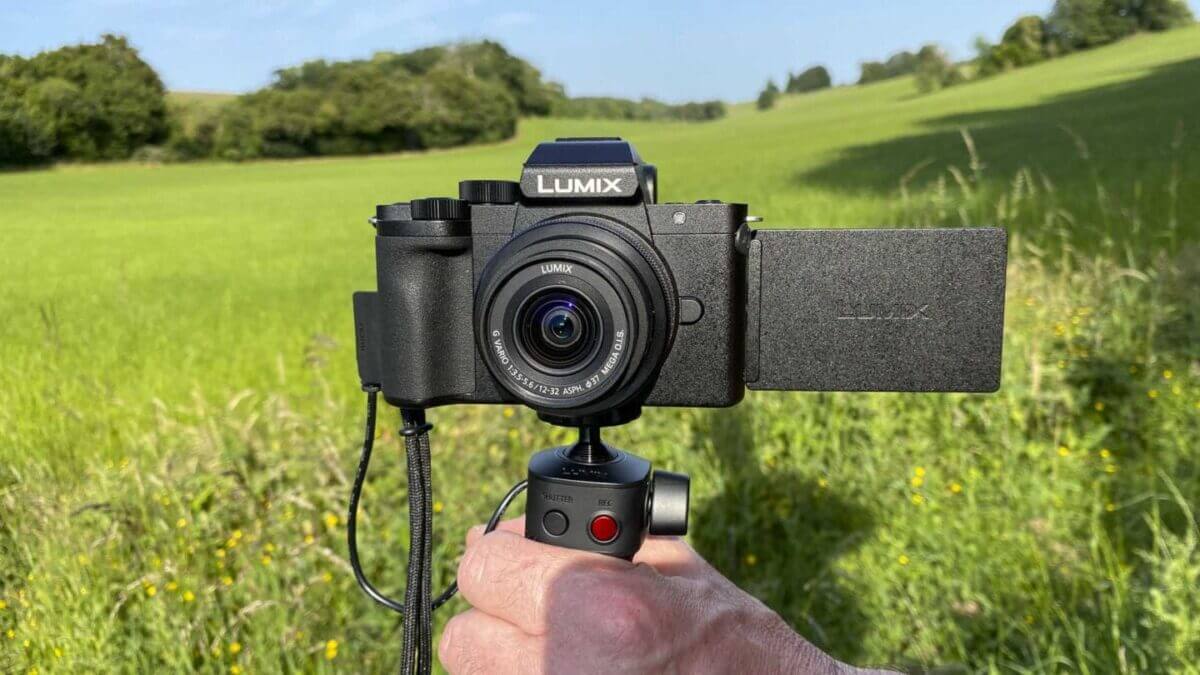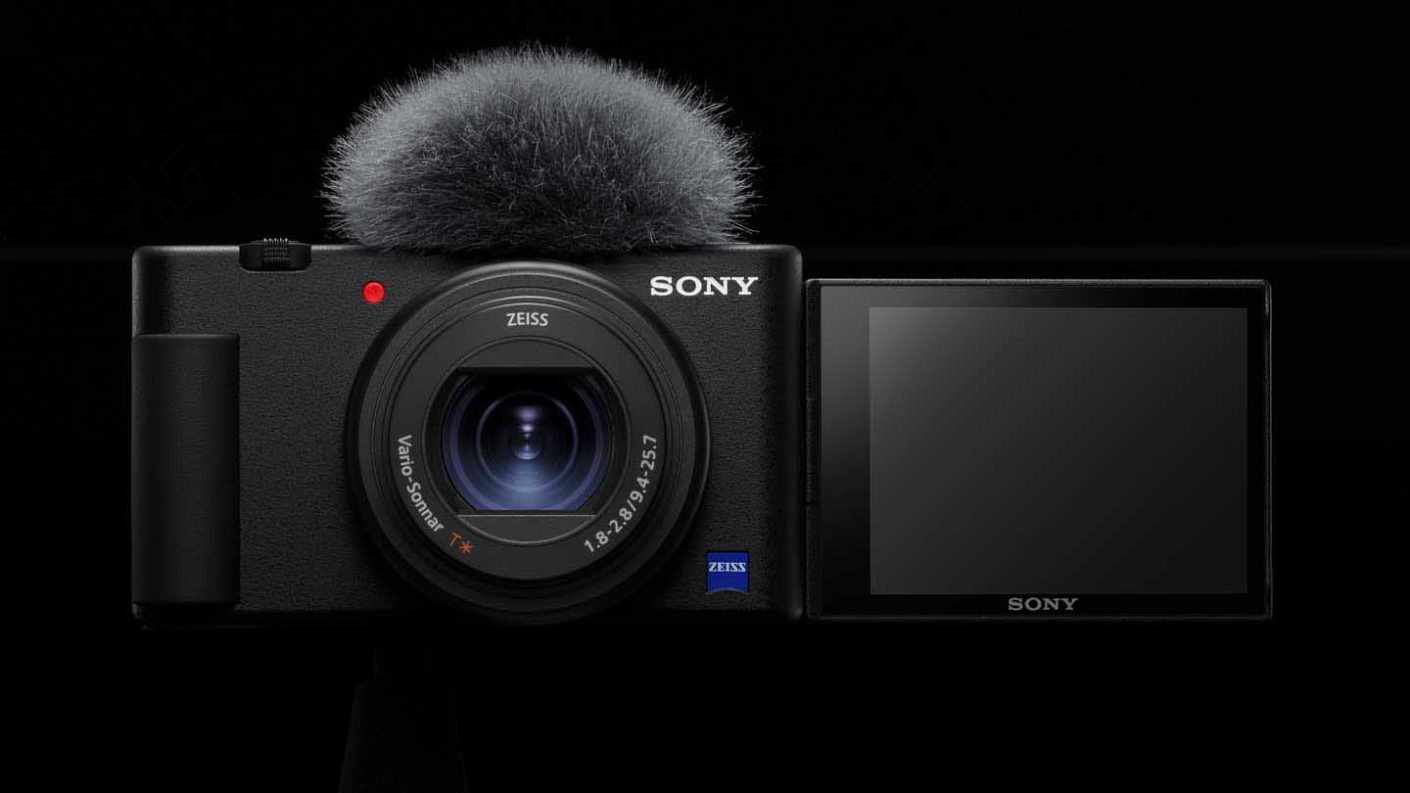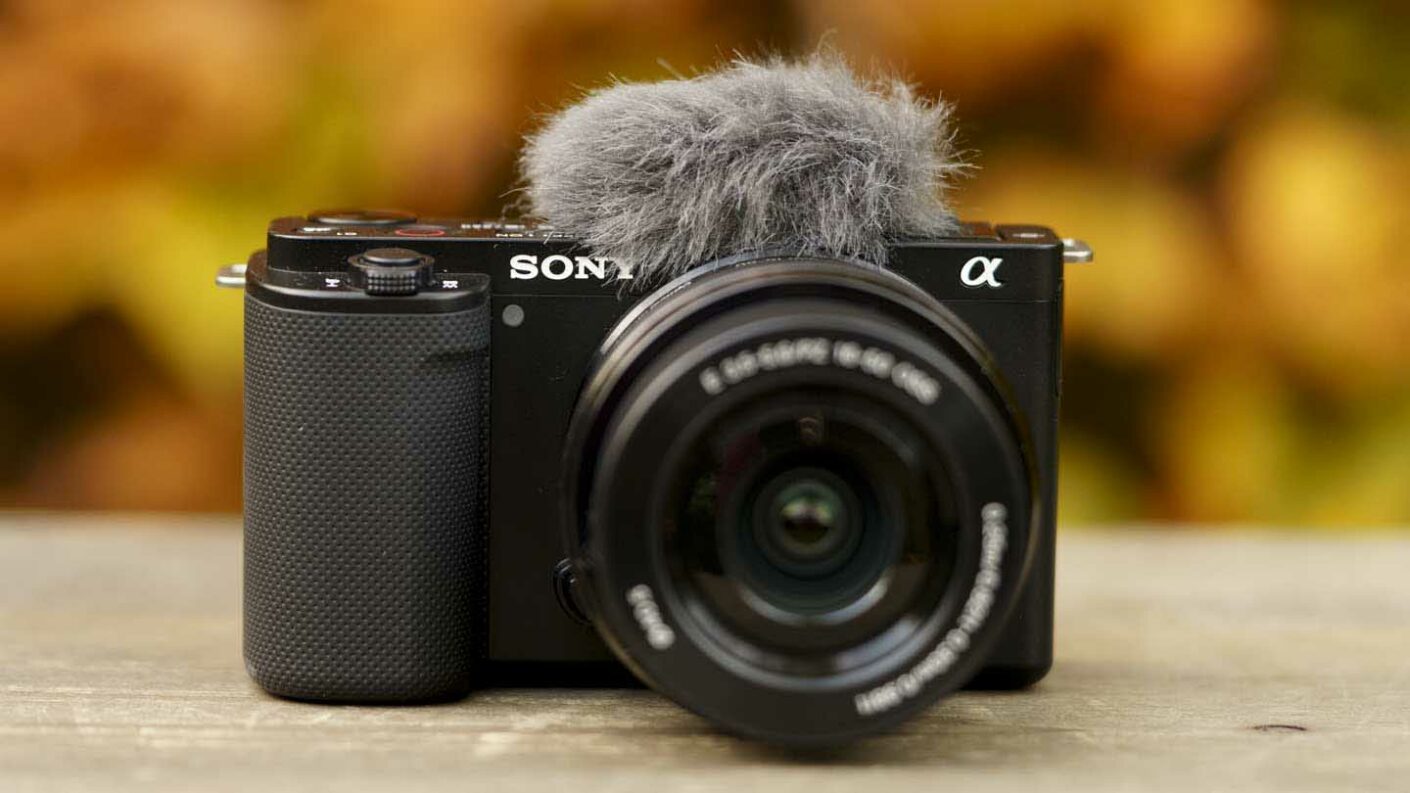Choosing the best video camera for beginners means finding an option that’s both affordable yet offers some of the features and specifications you need to get started with your creative endeavours. While you may not need specifications like 4K video capability when you’re getting started, you probably will find that you’ll need features like a flip out screen or an input for an external microphone.
If you plan to start vlogging, a flip out, or vari-angle, LCD screen means you can see yourself within the frame while filming, which is very useful. Likewise, an input for an external mic ensures you record better quality audio. The built-in mics on most cameras are good enough in quiet spaces, but they will pick up ambient noise and sometimes sound a bit tinny. Have a look at our guide to the best cameras for vlogging if this is the route you plan to go down.
What other features are important when choosing the best video cameras for beginners? Sensor size is, of course, important. But you don’t need a full-frame sensor when you’re starting out, and even some of the top content creators shoot with crop sensor cameras. A camera with an APS-C or Micro Four Thirds sensor will probably offer you the best balance of image quality and affordability. See our guides to the best APS-C cameras and best Micro Four Thirds cameras for more information.
Video quality is also a consideration. We said at the beginning that you don’t necessarily need 4K video capability when starting out. Posting an HD video on YouTube is perfectly acceptable. However, with 4K more ubiquitous now you can pick up some of the best 4K cameras for video at a more reasonable price tag than a few years ago. Also, as you get more experienced, being able to record in 4K allows you to crop into your footage in edit and still publish a detailed Full HD video. This is why many professional videographers are excited about the 8K capabilities of cameras like the Canon EOS R5 and Nikon Z9.
Another consideration, if your budget can stretch for it, is choosing one of the growing number of cameras with IBIS, or in-body image stabilisation. IBIS typically gives you up to around five stops of shutter speed compensation, making it easier to handhold the camera when filming.
Which camera is best for video shooting for beginners?
Only a few years ago, the answer to this question would have been a DSLR. But the rise of mirrorless cameras, with their smaller design, better AF systems and – in some cases – in-body image stabilisation, means that mirrorless cameras are the best video cameras for beginners. All of the options in our list below are mirrorless cameras.
The best video cameras for beginners you can buy today
Below are our picks for the best beginner video cameras based on our experience testing them. You can find links to our full reviews for each camera. You might also find our following video-based guides useful if you have a more specific need in mind.
- Best cameras for video
- Vlogging and streaming: the ultimate guide
- Best cameras for live streaming
- Best cameras for YouTube
- Best cameras for TikTok videos
- Best cameras for slow motion video
- Which cameras shoot 4K video at 60fps?
- Which cameras shoot 4K video at 120fps?
- Which cameras shoot 1080 at 240fps?
- Which cameras shoot 6K video?
- Best 4K cameras for shooting video
For a deeper dive into the many different camera types and features available, check out our range of camera buying guides.
Panasonic Lumix G100

Specification
- Camera type: Mirrorless
- Announced: 24th June 2020
- Sensor: 20.3Mp Four Thirds type CMOS
- Lens mount: Micro Four Thirds
- Screen: 3-inch 1,840,000-dot vari-angle touchscreen
- Viewfinder: 3,480,000-dot electronic viewfinder
- Key video specifications: 4K (3840x2160) at 24,25,30p and 100Mbps, V-Log L and Ozo Audio by Nokia
- Weight: 310g body only, 352g with SD card and battery, 412g with the 12-32mm lens
- Dimensions (WxHxD): 115.6x82.5x54.2mm
Panasonic designed the Lumix G100 as an entry-level vlogging camera but it also makes a good camera for beginner photographers and anyone looking to take a step up from their phone or a compact camera for shooting video.
The G100 has a 20.3Mp Four Thirds type CMOS sensor and the Micro Four Thirds lens mount. In addition to the vari-angle screen that allows vloggers to see themselves in front of the camera, the G100 has an electronic viewfinder built-in, which is good news for photography.
In addition to a 3.5mm port to connect an external mic, the G100 has a spatial audio recording system called OZO Audio by Nokia. This uses three internal microphones and can work in tandem with the face detection focusing to track the person talking and optimise the audio for them. It works very well provided that there’s no wind.
There are also some features for experienced videographers including V-Log L for creating low contrast, low saturation footage that’s suited to post-capture grading.
Control-wise the Panasonic G100 is fairly straightforward. There’s not an overwhelming array of buttons and dials, but you can access the key features quickly and there are twin dials for exposure control.
While the autofocus system isn’t quite as fast or decisive as the phase detection AF or hybrid systems in most other mirrorless cameras, and the eye AF isn’t 100% reliable, the G100 usually gets the subject sharp.
You can find the best deals on the Panasonic G100 at Amazon UK and Amazon US.
£590
$747.99For
- Very compact
- Viewfinder and vari-angle touchscreen
- Clever Ozo Audio by Nokia onboard
Fujifilm X-T30 II
Specification
- Camera type: APS-C format mirrorless
- Sensor: 26.1Mp APS-C (23.5mm×15.6mm) X-Trans CMOS 4
- Processor: X Processor 4
- Lens mount: Fujifilm X
- Sensitivity: Stills: ISO 160- 12800 expandable to ISO 80-51,200, Video: ISO 160- 12800 expandable to ISO 80-25,600
- Autofocus system: Intelligent Hybrid AF (TTL contrast AF / TTL phase detection AF) with up to 425 points in a 25x17 grid
- Viewfinder: Electronic 0.39 inch approx. 2.36 million dots OLED Colour
- Screen: 3.0-inch 1.62 million dots touchscreen with 100% coverage
- Key video specifications: DCI 4K (17:9) (4096 x 2160) at 29.97p/25p/24p/23.98p 200Mbps/100Mbps up to approx. 30min, 4K(16:9) (3840 x 2160) at 29.97p/25p/24p/23.98p 200Mbps/100Mbps up to approx. 30min, Full HD(17:9) (2048 x 1080) at 59.94p/50p/29.97p/25p/24p/23.98p 200Mbps/100Mbps up to approx. 30min.
- Maximum continuous shooting: Electronic shutter: 20fps for JPEG: 79 frames, Compressed RAW: 20 frames, Lossless compression RAW: 17 frames, Uncompressed RAW: 17 frames, Mechanical shutter: 8fps for JPEG: 105 frames, Compressed RAW: 23 frames, Lossless compression RAW: 18 frames, Uncompressed RAW: 18 frames
- Dimensions (WxHxD): 118.4 x 82.8 x 46.8mm / 4.66 x 3.26 x 1.84-inch
- Weight: 382g including battery and memory card, 329g body only
The lone physical upgrade that the X-T30 makes on the Fuji X-T30 is the switch to a 1.62-million dot screen on its back rather than a 1.04-million-dot unit.
The upgrades come as a result of firmware and algorithm improvements. For example, the X-T30 II gains the enhanced autofocus algorithms seen on the X-T4, which means it is faster and has improved low-light sensitivity – down to -7.0EV with the XF50mm F1.0 lens mounted. The Face/Eye detection is also more reliable, but it’s still only of use when photographing humans.
Fujifilm has also given the X-T30 II two additional Film Simulation modes, Classic Neg and Eterna Bleach Bypass. In addition, there are controls to adjust the Clarity, Tone Curve and Monochromatic Color while the Auto White Balance can be set to White Priority and Ambience Priority, and there’s the Color Chrome FX Blue option to enhance blue subjects.
In another useful improvement, the X-T30 II is capable of recording 4K video continuously for up to 30minutes whereas the X-T30 is limited to 20 minutes.
Find the best deals on the Fujifilm X-T30 II at Amazon UK and Amazon US.
£770
$899For
- Excellent sensor
- Robust construction
- Traditional controls
Canon EOS M50 Mark II
Specification
- Camera type: Mirrorless
- Announced: USA: 14th October 2020, UK: 25th February 2021
- Sensor: 24.1Mp APS-C format (22.3 x 14.9mm) CMOS
- Processor: Digic 8
- Lens mount: Canon EF-M
- Sensitivity range: Stills: ISO 100-25,600 expandable to ISO 51,200, 4K Video: ISO 100-6400, Full HD & HD: ISO 100-12,800 expandable to ISO 25,600
- AF system: Dual Pixel CMOS phase detection with up to 3975 positions and 143 automatically selectable points
- Viewfinder: 0.39-type 2,360,000-dots OLED EVF
- Screen: Touch-sensitive vari-angle 3.0-inch LCD with 1,040,000 dots
- Video resolution: 4K (3840 x 2160) at 23.98, 25 fps Full HD: (1920 x 1080) at 59.94, 50, 29.97, 25, 23.976 fps), HD (1280 x 720) at 119.9, 100, 59.94, 50 fps
- Max continuous shooting rate: 10fps for up to 36Jpegs or 10 raw files
- Shutter speed range: 30-1/400 sec, Bulb
- Built-in flash: GN (ISO 100) 5
- Battery: Li-ion LP-E12, Viewfinder: Approx. 250 shots Live view: Approx 305 shots
- Dimensions (W x H x D): 116.3 x 88.1 x 58.7mm
- Weight: 387g (black), 390g (white) including battery and memory card
The Canon EOS M50 Mark II makes a relatively modest update on one of Canon’s most popular mirrorless cameras. Inside it has the same 24Mp APS-C format sensor paired with the same Digic 8 processing engine.
Like its predecessor, the Canon EOS M50 Mark II can shoot 4K video at up to 24p but there’s an additional 1.5x crop applied to the framing and the autofocus system relies on contrast detection. Switch to Full HD or stills shooting and the phase detection system that is enabled by the Dual Pixel sensor design becomes active.
The key upgrades made for the Mark II are eye tracking in both stills and video mode, vertical video recording and the ability to stream live to YouTube video a smartphone hotspot.
Find the best deals on the Canon EOS M50 Mark II at Amazon UK and Amazon US.
£589
$599For
- Excellent image quality
- Superb implementation of touch-control
- Good-quality viewfinder built-in
Nikon Z50
Specification
- Camera type: Mirrorless
- Sensor: 20.88Mp APS-C / DX (23.5x15.7mm) CMOS
- Processing engine: Expeed 6
- Lens mount: Nikon Z mount
- Sensitivity range: ISO 100-51,200; expands to 204,800
- Viewfinder: 0.39-inch 2,360,000-dot OLED electronic viewfinder
- Screen: Tilting 3.2–inch 1,040,000-dot touchscreen
- Autofocus: Hybrid (phase and contrast detection) AF with 209 AF points, Eye AF and Subject Tracking. Firmware V.20 adds Eye-detection AF for Animals as well as humans
- Continuous Shooting: 11fps with continuous AF and exposure metering
- Video: 4K at 30fps and Full-HD at 120fps
- Storage: SD/SDHC/SDXC UHS-I
- Connectivity: Snapbridge 2.6; Wi-Fi, Bluetooth
- Dimensions (W x H x D): 126.5 x 93.5 x 60 mm / 5 x 3.7 x 2.4-inches
- Weight: 450g / 15.9oz with battery and memory card but without body cap, 395g /14oz body only
The Nikon Z6 and Z7 are great, but not all photographers want a full-frame camera. The Nikon Z50 offers that alternative for Nikon users wanting a mirrorless camera, and it has plenty to offer experienced photographers thanks to a solid build and a comprehensive feature set.
Its autofocus system is excellent and is capable of capturing fast-moving subjects in pin-sharp focus, even in gloomy conditions. Further good news is that the Z50 has both Subject Tracking and Eye AF modes. Eye AF is a must-have feature at the moment and it’s incredibly useful for portraits and social event photography.
Subject Tracking works in Auto-area AF mode and it’s useful for subjects that move erratically. Pressing the OK button in Auto-area AF mode activates a tracking point which is visible on the screen and in the viewfinder.
You then position this box over the subject and press the OK button again to start the tracking. As the subject moves, the Z50 tracks it around the frame, keeping it sharp in Continuous AF mode.
Inside the Nikon Z50 is a new 20.88Mp APS-C format sensor which is paired with the Expeed 6 processing engine. Together, these enable a native sensitivity range for stills of ISO 100-51,200 with expansion settings going all the way up to ISO 204,800. Meanwhile, the video range is ISO 100-25,600.
Thanks to the Expeed 6 processing engine, the Z50 can shoot at up to 11 frames per second with continuous autofocusing and exposure metering. This rate is achieved in Continuous High Plus mode while the maximum rate in Continuous High mode is 5fps.
The Nikon Z50 also delivers great video, capturing 4K at 30fps and Full HD at a range of frame rates.
Find the best deals on the Nikon Z50 at Amazon UK and Amazon US.
£849
$989For
- Superb build and handling
- AF fast and accurate in low light
- Weatherproof
Sony ZV-1

Specification
- Camera type: Compact
- Announced: 26th May 2020
- Sensor: 20.1Mp 1-inch type (13.2mm x 8.8mm) Exmor RS CMOS
- Lens: Zeiss Vario-Sonnar T* 9.4-25.7mmm (24-70mm equivalent) f/1.8-2.8
- Sensitivity range: Stills: ISO 100-25,600, Video: ISO 125-12,800
- Autofocus: 315 focal-plane phase-detection AF points, Eye AF: Humans (stills and video) or Animal (stills)
- Burst Mode: Hi: 24fps, Mid: 10fps, Low: 3fps
- Video: 4K in-body movie recording with full pixel readout and no binning, Log & Gamma options, slow-mo at up to 1000fps
- Viewfinder: No
- Screen: Vari-angle 3-inch touchscreen
- Stabilisation: Optical for stills, optical and electronic for video
- Hotshoe: Multi-interface (can connect an XLR mic via an adapter)
- Storage: SD/SDHC/SDXC
- Dimensions (WxHxD): 105.5 x 60 x 43.5mm / 4 1/4 × 2 3/8 × 1 3/4inches
- Weight: 294g with battery and SD card or body only
It used to be that most vlogging was done on a phone, but Sony aimed to change the game plans of thousands of content creators when it launched the ZV-1, a compact camera specifically designed for vloggers.
Much of the specification on the Sony ZV-1 is familiar from the Sony RX100 series of compact cameras, but there are a few notable differences to make it better for vlogging.
Inside the Sony ZV-1 is a 1-inch type stacked Exmor RS CMOS sensor with 20.1 million effective pixels. That’s a comparatively large sensor for a compact camera and makes a big impact on image quality. What’s more, the Exmor RS CMOS sensor brings phase-detection focusing – which is usually faster and more decisive than contrast detection. The ZV-1 has a total of 315 phase detection AF points which are available for use in stills and video mode.
As for video, the ZV-1 is capable of shooting 4K footage and exposure can be controlled automatically or manually.
Sound is just as important as the image quality in video and the Sony ZV-1 offers a number of options for recording audio. The easiest is to use the built-in 3-capsule microphone. This uses technology from Sony’s advanced video camera systems and there’s a Clear Voice function that can reduce background noise while making human voices clearer.
Overall, the Sony ZV-1 delivers everything a vlogger could wish for in a compact camera, and it comes with Sony’s excellent AF system. There are features to help inexperienced photographers/videographers/vloggers get good results, the exposure can be controlled automatically or manually and there’s a built-in ND filter plus Log and Gamma control. It makes it easy to produce great 4K video but lets you take control when you want to. It all adds up to a very enticing camera for vloggers.
Find the best deals on the Sony ZV-1 at Amazon UK and Amazon US.
£700
$749.99For
- Designed specifically for vloggers but also a capable stills camera
- Stabilised 4K video
- Vari-angle touchscreen
Sony ZV-E10

Specification
- Camera type: Mirrorless
- Announced: 27th July 2021
- Sensor: 24.2Mp APS-C format (23.5mm x 15.6mm) Exmor CMOS
- Sensitivity range: Stills: ISO 100-32,000 expandable to ISO 50-51,200, Video: ISO 100-32,000
- Autofocus: 425 phase-detection AF points, 425 contrast-detection AF points, Eye AF: Humans or Animal (stills and video)
- Burst Mode: Hi+: 11fps, Hi: 8fps, Mid: 6fps, Low: 3fps
- Video: 4K 3840 x 2160 (4:2:0, 8bit, NTSC) 30p (100Mbps / 60Mbps), 3840 x 2160 (4:2:0, 8bit, NTSC) 24p (100Mbps / 60Mbps), 3840 x 2160 (4:2:0, 8bit, PAL) 25p (100Mbps / 60Mbps)
- Viewfinder: No
- Screen: Vari-angle 3-inch 921,600-dot touchscreen
- Stabilisation: Electronic for video - SteadyShot Standard or SteadyShot Active
- Hotshoe: Multi-interface
- Storage: SD/SDHC/SDXC
- Dimensions (WxHxD): 115.2 x 64.2 x 44.8 mm / 4 5/8 x 2 5/8 x 1 13/16 inches from grip to monitor
- Weight: 343g / 12.1oz with battery and SD card
The Sony ZV-E10 has a 24.2-megapixel APS-C Exmor CMOS sensor and a BIONZ X image processing engine. It also has some of the vlogging-specific features found on the ZV-1 compact camera including “Background Defocus” which enables quick switching between a blurred background and a sharp background.
There’s also the “Product Showcase Setting” mode that sets the camera to change the focus automatically from the subject’s face to an object being held to the camera.
There are also some advanced video features such as 4K (3840 x 2160) video shooting and Full HD Slow Motion at up to 120). Plus, electronic image stabilisation with Active Mode for stable video recording when walking and shooting hand-held.
Further, the ZV-E10’s advanced autofocus technology provides fast, precise AF with tracking and there’s a high-quality audio system.
Find the latest deals on the Sony ZV-E10 at Amazon UK and Amazon US.
£680
$698For
- Designed specifically for vloggers but also a capable stills camera
- Great AF system
- Good audio options




Leave a Reply
You must be logged in to post a comment.